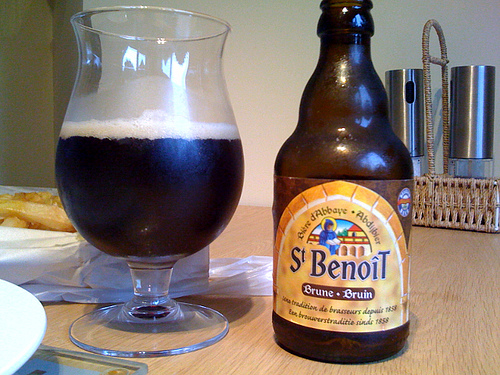Culture
The Man Who Invented Beer: Saint-Benoit Brune

Every week in The Man Who Invented Beer, Adam Cowden runs down the latest in craft beers, with some history for extra flavor.
How was your spring break? Probably not as good as mine. I’m fresh back from Italy, the land of food, vino, and lots of really old shit. For the most part, I tried to adhere to the “When in Rome…” thing, but I, like Ron Burgundy, am still getting the hang of that expression, and I found more than a few chances to get away from the wine and enjoy a few new brews. My favorite of the trip was a Belgian Trappist-style beer that I found at the English-themed Bulldog Inn in Rome called Saint-Benoît Brune.
What’s the story?
Brasserie du Bocq is a small, family-owned brewery located in Wallonia, the Southern, French-speaking region of Belgium. Started in 1858 as the small, wintertime brewing enterprise of farmer Martin Belot, the brewery produced its first mass-produced beer “La Gauloise” shortly after WWI. Nowadays, the company produces a handful of beers that span the range of Belgian styles, including Belgian blondes, brunes, and ambers, fruit-flavored Lambic ales, strong pale-ales (tripels), strong brown beers (dubbels), a light, refreshing Saison beer, a white witbier, and a dark, spiced Christmas beer.
Why should I drink it?
Belgian beer is a sort of world unto itself. The minute country of 11 million produces over 1,100 different varieties of beer, and the aforementioned styles are bound together only by their characteristic pronounced flavorfulness and dissimilarity from the mass of beers produced elsewhere in the world. Belgian beers are usually top-fermented, often strong, and often include the addition of fruit or candy sugar in the wort to enhance flavor and fermentation. In particular, Belgian Trappist beer, brewed by monks in Trappist monasteries, is widely considered the best in the world. Do not mistake St. Benoit or any of Brasserie du Bocq’s other products for true Trappist beers, though. “Trappist beer” is a designation of origin rather than a designation of style (there is a “Trappist” style of beer); brewers have to meet a very specific and narrow set of qualifications in order to use the “Authentic Trappist” label, and there are only seven breweries in the world that meet this standard. These qualifications include:
1. The beer must be brewed within the walls of a Trappist abbey (an abbey of the Cistercian Order of Strict Observance) or within the immediate vicinity.
2. The equipment necessary to the production must clearly express a dependency in regard to the monastery (huh?).
3. The product must be made by or under the supervision of the monastery community.
4. The largest part of the profit must be spent on social work.
Not meeting any of these conditions, St. Benoit is classified as an abbey beer, a beer that is influenced by and brewed according to Trappist traditions despite not qualifying as a Trappist beer. St. Benoit, in fact, is the French name of St. Benedict, the founder of the monastic order to which Trappists ultimately trace their origin. St. Benoit, like authentic Trappist beer, is bottle conditioned, and the addition of yeast and sugar to the bottle means that the beer is a live product that continues to ferment after the bottling process. This is also means that the beer has a very long shelf life (according to some, bottle-conditioned beer actually gets better with age), that the carbonation results naturally from the action of the yeast rather than the addition of gas, and that the beer can be better preserved without the addition of artificial preservatives. Brasserie du Bocq is also smaller than several of the Trappist breweries, with an annual output that’s at least twice as small as Chimay, the most recognizable Trappist brand.
What does it taste like?
Sweet nectar. The full-bodied taste, which is overwhelmingly sweet with a little bit cinnamon-like spice, masks any trace of the alcohol content, and it’s got a distinct banana aftertaste not unlike a hefeweizen. Really, it reminded me most of Hofbrau Dunkel…or maybe a Hofbrau Dunkel mixed with a tiny bit of a hefeweizen. A mouthful of the stuff is creamy and smooth, and the carbonation is not at all harsh or unpleasant (I assume this has something to do with the natural rather than force carbonation). Served in one of those small, wine-glass-like Trappist goblets, it had a thick head of foam that took up nearly a third of the glass.
At 6.5% ABV, the beer is semi-strong but still very drinkable. If it were much stronger, it would have probably been labeled a dubbel (traditionally Trappist strong-dark ale), but at this relatively low ABV it’s simply a brune. Make no mistake, though: you’ll start to notice some slurring after just two or three of these.
Should I try it?
Definitely…if you can find it. Brasserie du Bocq exports mainly to Europe, Australia, and Japan, and I don’t know that I’ve yet seen it here in the US. I did find this nifty website that lets you order beers from around the world, though, so if you’re really desperate to try one you could have it shipped right to your door. If not, try one if you ever find yourself thirsty in Rome, or better yet, Belgium.
Rating: 8/10
Pingback: The Man Who Invented Beer: Maredsous 8 Brune | Heave Media()